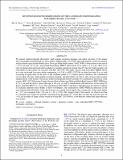MULTIWAVELENGTH OBSERVATIONS OF THE CANDIDATE DISINTEGRATING SUB-MERCURY KIC 12557548B
Author(s)
Croll, Bryce J.; DeVore, John; Gilliland, Ronald L.; Crepp, Justin R.; Howard, Andrew W.; Star, Kimberly M.; Chiang, Eugene; Levine, Alan M.; Jenkins, Jon M.; Albert, Loic; Bonomo, Aldo S.; Fortney, Jonathan J.; Isaacson, Howard; Rappaport, Saul A; ... Show more Show less
DownloadCroll-2014-Multiwavelength obse.pdf (4.844Mb)
PUBLISHER_POLICY
Publisher Policy
Article is made available in accordance with the publisher's policy and may be subject to US copyright law. Please refer to the publisher's site for terms of use.
Terms of use
Metadata
Show full item recordAbstract
We present multiwavelength photometry, high angular resolution imaging, and radial velocities of the unique and confounding disintegrating low-mass planet candidate KIC 12557548b. Our high angular resolution imaging, which includes space-based Hubble Space Telescope Wide Field Camera 3 (HST/WFC3) observations in the optical (~0.53 μm and ~0.77 μm), and ground-based Keck/NIRC2 observations in K' band (~2.12 μm), allow us to rule out background and foreground candidates at angular separations greater than 0.''2 that are bright enough to be responsible for the transits we associate with KIC 12557548. Our radial velocity limit from Keck/HIRES allows us to rule out bound, low-mass stellar companions (~0.2 M ☉) to KIC 12557548 on orbits less than 10 yr, as well as placing an upper limit on the mass of the candidate planet of 1.2 Jupiter masses; therefore, the combination of our radial velocities, high angular resolution imaging, and photometry are able to rule out most false positive interpretations of the transits. Our precise multiwavelength photometry includes two simultaneous detections of the transit of KIC 12557548b using Canada-France-Hawaii Telescope/Wide-field InfraRed Camera (CFHT/WIRCam) at 2.15 μm and the Kepler space telescope at 0.6 μm, as well as simultaneous null-detections of the transit by Kepler and HST/WFC3 at 1.4 μm. Our simultaneous HST/WFC3 and Kepler null-detections provide no evidence for radically different transit depths at these wavelengths. Our simultaneous CFHT/WIRCam detections in the near-infrared and with Kepler in the optical reveal very similar transit depths (the average ratio of the transit depths at ~2.15 μm compared with ~0.6 μm is: 1.02 ± 0.20). This suggests that if the transits we observe are due to scattering from single-size particles streaming from the planet in a comet-like tail, then the particles must be ~0.5 μm in radius or larger, which would favor that KIC 12557548b is a sub-Mercury rather than super-Mercury mass planet.
Date issued
2014-05Department
Massachusetts Institute of Technology. Department of Physics; MIT Kavli Institute for Astrophysics and Space ResearchJournal
Astrophysical Journal
Publisher
Institute of Physics/American Astronomical Society
Citation
Croll, Bryce, Saul Rappaport, John DeVore, Ronald L. Gilliland, Justin R. Crepp, Andrew W. Howard, Kimberly M. Star, et al. “MULTIWAVELENGTH OBSERVATIONS OF THE CANDIDATE DISINTEGRATING SUB-MERCURY KIC 12557548B, ,” The Astrophysical Journal 786, no. 2 (April 22, 2014): 100. © 2014 American Astronomical Society.
Version: Final published version
ISSN
0004-637X
1538-4357